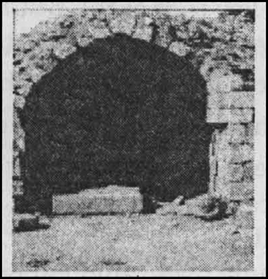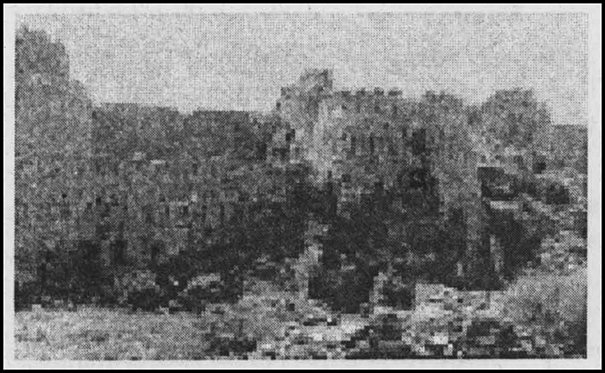Through The Eyes Of Travellers
Here is an excerpt from Ibn Battuta’s account of Delhi, often spelt as Dehli in texts of the period:
Fig. : An arch in Tughlakabad, Delhi
The city of Delhi covers a wide area and has a large population. The rampart round the city is without parallel. The breadth of its wall is eleven cubits; and inside it are houses for the night senty and gate keepers. Inside the ramparts, there are store-houses for storing edibles, magazines, ammunition, ballistas and siege machines. The grains that are stored (in these ramparts) can last for a long time, without rotting...In the interior of the rampart, horsemen as well as infantrymen move from one end of the city to another. The rampart is pierced through by windows which open on the side of the city, and it is through these windows that light enters inside. The lower part of the rampart is built of stone; the upper part of bricks. It has many towers close to one another. There are twenty eight gates of this city which are called darwaza and of these, the Budaun Darwaza is the greatest; inside the Mandwi darwaza there is a grain market; adjacent to the Gul Darwaza there is an orchard.... It (the city of Delhi) has a fine cemetery in which graves have domes over them, and those that do not have a dome, have an arch, for sure. In the cemetery they sow flowers such as tuberose, jasmine, wild rose, etc,; and flowers blossom there in all seasons. Questions :

Fig.: Part of the fortification wall of the settlement
(i) How had Ibn Battuta described the cities in the sub-continent?
(ii) What was his description of Delhi?
(i) How had Ibn Battuta described the cities in the sub-continent?
(ii) What was his description of Delhi?
(iii) Mention any four changes in Delhi of today.
(iii) Mention any four changes in Delhi of today.
(i) Ibn Battuta had described several cities of the Indian sub-continent which were visited by him. He found cities in the subcontinent full of exciting opportunities for those who had the necessary drive, resources and skills. Ibn Buttuta mentioned that in these cities there were densely population. The people were very prosperous but sometimes most of the cities are disturbed and a lot of destruction of men and property was caused by wars and invaders.
According to him most cities in the subcontinent had crowded streets and bright and colourful markets. That were stacked with wide variety of goods.
(ii) According to Ibn Buttuta that Delhi was a vast city, with a great population, the largest in India. This city was having rivalry with a prominant city of South India named Daulatabad (in Maharashtra) because Daulatabad was more less and no less in Delhi as far as size and glamour of the city was concern.
According to Ibn Buttata the rampart round Delhi is without parallel. The breadth of its wall is eleven cubits, and inside it are houses for the night sentry and gatekeepers. Inside the ramparts, there are store houses for storing edibles, magazines, ammunition, ballistas and siege machines. There is a grain market, orchard and fine cemetery in which graves have domes over them.
(iii) We can mentioned the following major changes in Delhi of today :
(a) Delhi has been working as capital city of whole India and its total area is more wide and large in population than the visiting time of Ibn Battuta.
(b) The city is not encircled by a great thick wall like of medieval age. Infact modern Delhi is divided into two major parts popularly known as Old Delhi and New Delhi.
(c) Delhi is having very ultramodern markets like Connaught Place, Karol Bagh, Kamla Nagar, Chandni Chowk and so on. There are a grand Palace or building for head of the State of India i.e. The President. There are numerous important government buildings such as the Parliament and the Supreme Court etc.
Sponsor Area
Some More Questions From Through The Eyes Of Travellers Chapter
Compare and contrast the perspectives from which Ibn-Battuta and Bernier wrote their accounts of their travels in India.
Discuss the picture of urban centres that emerges from Bernier’s account.
Analyse the evidence for slavery provided by Ibn-Battuta.
What were the elements of the practice of sati that drew the attention of Bernier?
Discuss Al-Biruni’s understanding of the caste system.
Do you think Ibn Battuta’s account is useful in arriving at an understanding of life in contemporary urban centres? Give reasons for your answer.
Discuss the extent to which Bernier’s account enables historians to reconstruct contemporary rural society.
Read this excerpt from Bernier:
“Numerous are the instances of handsome pieces of workmanship made by persons destitute of tools, and who can scarcerly be said to have received instruction from a master. Sometimes they imitate so perfectly articles of European manufacture that the difference between the original and copy can hardly be discerned. Among other things, the Indians make excellent muskets, and gold fowling-pieces, and such beautiful gold ornaments that it may be doubted if the exquisite workmanship of those articles can he exceeded by any European goldsmith. I have often admired the beauty, softness and delicacy of their paintings.”
List the crafts mentioned in the passage. Compare those with the descriptions of artisanal activity in the chapter.
On an outline map of the world mark the countries visited by Ibn Battuta. What are the seas that he may have crossed?
For any one of the travellers mentioned in the chapter, find out more about his life and writings. Prepare a report on his travels, noting in particular how he described society, and comparing these descriptions with the excerpts included in the chapter.
Mock Test Series
Sponsor Area
NCERT Book Store
NCERT Sample Papers
Sponsor Area